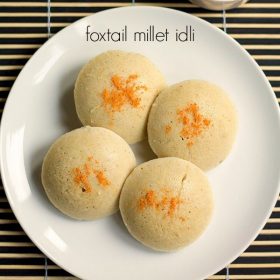Millet Idli (With Foxtail Millet)
Millet Idli are light, fluffy, savory idli variation made with foxtail millet, lentils and rice. Foxtail millet is also known as 'navane' in kannada, 'thinai' in tamil, 'kangni' in hindi, 'korralu' in telugu.
Servings: 14 Millet Idli
Calories: 93kcal
Ingredients
- 200 grams foxtail millet (navane or kangni or thinai or korra) or 1 cup thinai
- 80 grams idli rice or raw rice or ⅓ cup rice - I used sona masoori rice
- 80 grams urad dal or ⅓ cup urad dal
- 1.5 teaspoon fenugreek seeds
- salt to taste
- water - as required for grinding, approximately ¼ cup and 2 tablespoons water
Instructions
Soaking millet and grinding the batter
- First wash the foxtail millet and rice twice with water. Drain, soak with fresh water for 4 to 5 hours.
- Rinse, drain and soak urad dal and 1½ teaspoon methi seeds together separately for 4 to 5 hours.
- Then, drain the millet-rice mixture, discard the water. Add this to the mixer/grinder.
- Grind adding about ¼ cup of water in small amounts, grind to form a slightly grainy, neither too thin nor too thick batter. Pour this into another deep container.
- Drain the urad dal-methi seeds mixture. Retain the water.
- Add the dal, methi seeds to the same mixer/grinder and grind adding about 2 tablespoons of reserved water to form a smooth mixture.
- Pour this to the same deep container. Mix both the batters well adding salt to taste.
Fermenting batter
- Cover and place in a warm area to ferment overnight (about 8 to 10 hours).
- The next morning, the batter should have risen well. You will be able to note bubbles of fermentation as you stir gently with a ladle.
Making thinai idli
- To make the millet idli, add water to the steamer or a large pot and heat.
- Meanwhile, grease the idli moulds with oil.
- Pour batter into each of the depressions.
- Place the filled idli stand inside the steamer once it begins to steam.
- Cover and steam for 12 to 14 minutes or until a fork/knife inserted at the center of the idli comes out clean.
- Remove the idli plates.
- Using a spoon dipped in water, slide along the base of each idli and remove carefully.
- Serve Millet Idli with chutney/sambar of your choice.
Notes
- If you live in a cold region, pre-heat the oven to 50 degrees Celsius. Place the container inside. Remember to turn off the heat when you place the container inside the oven. But leave the oven light on. Allow the batter to ferment overnight.
- The recipe can be scaled to make a small batch or make more servings.
- Warm temperature is crucial for proper fermentation. In cooler climates, the batter will take more time to ferment.
Nutrition
Calories: 93kcal | Carbohydrates: 18g | Protein: 3g | Fat: 1g | Saturated Fat: 0.1g | Polyunsaturated Fat: 0.3g | Monounsaturated Fat: 0.1g | Sodium: 84mg | Potassium: 36mg | Fiber: 3g | Vitamin A: 1IU | Vitamin B1 (Thiamine): 0.1mg | Vitamin B2 (Riboflavin): 0.05mg | Vitamin B3 (Niacin): 1mg | Vitamin B6: 0.1mg | Vitamin C: 0.3mg | Vitamin E: 0.01mg | Vitamin K: 0.1µg | Calcium: 6mg | Vitamin B9 (Folate): 26µg | Iron: 1mg | Magnesium: 18mg | Phosphorus: 47mg | Zinc: 0.3mg
